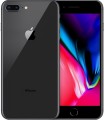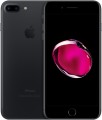Display-to-body ratio
The ratio of the screen area to the total front panel area of the phone. Simply put, this spec describes how much of the front panel is occupied by the screen; the rest is the bezels.
This indicator is given exclusively for smartphones with touch screens — it is for them that it is most relevant. The larger the percentage of the body is occupied by the screen, the thinner are the bezels, the neater the smartphone looks and the more convenient it is to work with it with one hand. As for specific numbers, the average values are 80 – 85 %, the higher values allow us to talk about a
thin bezel, and more than 90 % — about a
“bezel less” design.
Separately, we note that this parameter has nothing to do with the aspect ratio of the screen. The aspect ratio describes only the display itself — its proportions, the ratio between the larger and smaller side of the rectangle.
CPU model
The most popular nowadays are chips from
Qualcomm and
MediaTek, CPUs from
Unisoc are slightly less common. Qualcomm has several processors of each series, namely
Snapdragon 778G,
Snapdragon 7 Gen 1,
Snapdragon 7+ Gen 2,
Snapdragon 7s Gen 2,
Snapdragon 7 Gen 3,
Snapdragon 7+ Gen 3,
Snapdragon 865,
Snapdragon 870,
Snapdragon 888,
Snapdragon 8 Gen 1,
Snapdragon 8+ Gen 1,
Snapdragon 8 Gen 2,
Snapdragon 8 Gen 3,
Snapdragon 8s Gen 3. And Mediatek has a low cost series
MediaTek Helio P and a line of advanced chipsets
MediaTek Dimensity (
Dimensity 1000,
Dimensity 7000,
Dimensity 8000,
Dimensity 9000).
Knowing the name of the CPU model installed in the smartphone, you can find detailed data on a particula
...r CPU and evaluate its level and general capabilities. This is especially true in light of the fact that these capabilities depend not only on the number of cores and clock speed, but also on the specific nuances of the design.CPU frequency
The clock frequency of the CPU that the device is equipped with. For multi-core processors, which are standard in modern smartphones, the frequency of each individual core is implied; and if the processor has cores with different frequencies (see "Number of cores") — usually, the maximum indicator is given.
In general,
high performance smartphones have high frequency of the processor. However, note that this parameter itself is not directly related to the capabilities of the CPU: many other features of the chip affect the actual performance, and often a low cost solution with a higher clock speed turns out to be less performant than an expensive one, and at the same time, presumably, more "slow" processor. In addition, the overall performance of the system directly depends on a whole set of other factors — primarily the amount of RAM. Therefore, when evaluating a smartphone, it is worth focus not so much on the frequency of the processor, but on the general specs of the system and visual indicators like the results in tests (see below).
CPU cores
The number of cores in the processor of a mobile phone.
The core in this specific case refers to the part of the processor that executes one thread of commands. Accordingly, the presence of multiple cores allows you to work with multiple threads simultaneously, which has a positive effect on performance. At the same time multi-core CPUs are now found even in the most inexpensive modern smartphones — even
chips with 8 cores are not uncommon among them, not to mention simpler
quad -core and
six-core solutions. And some modern processors can have up to
10 cores.
Theoretically, more cores can improve processor efficiency. However, in fact, the performance of the CPU (and the smartphone itself, eventually) depends on many additional factors. Thus the number of cores is purely a reference parameter. For example, a high-end quad-core processor may be much more performant than an inexpensive eight-core one. So you really should focus on overall level of performance and the results shown in various tests (see below)
It is also worth mentioning that individual cores of mobile CPUs may vary in clock speed, performance and power consumption. The classic version is 8 cores working according to the “4 + 4” scheme: 4 relatively “weak” and power efficient cores are responsible for simple tasks like Internet surfing, and ano
...ther 4 – more powerful ones - turn on when high performance is required (for example, in games with advanced graphics). This scheme of work allows you to achieve the optimal balance between performance and energy efficiency of CPU.Test results
The test results are specified either by a younger model in a line or a particular model, made for a better understanding performance of phone models if you compare phones against these parameters. For example, the 128 GB model has test results, and the 256 GB model has no information on the network, and in both models you will see the same value that will give an understanding of the overall performance of the device. But if the editorial office has information for each model individually, then each model will have its test results filled out, and the model with bigger RAM will have bigger values.
AnTuTu Benchmark
The result shown by a device when undergoing a performance test (benchmark) in AnTuTu Benchmark.
AnTuTu Benchmark is a comprehensive test designed specifically for mobile devices, primarily smartphones and tablets. It evaluates the efficiency of the processor, memory, graphics, and input/output systems, providing a clear impression of the system's capabilities. The higher the performance, the more points are awarded. Smartphones that score over 1.1M points are considered
high-performance according to the AnTuTu ranking.
Like any benchmark, this test does not provide absolute precision: the same device can show different results, usually with deviations within 5-7%. These deviations depend on various factors unrelated to the system itself, such as the device's load from third-party programs and the ambient temperature during testing. Therefore, significant differences between two models can only be noted when the gap in their scores exceeds this margin of error.
Geekbench
The result shown by a device when undergoing a performance test (benchmark) in Geekbench.
Geekbench is a specialized benchmark designed for processors. Since version 4.0, it also includes tests for graphics processors, and by the end of 2019, version 5 of the benchmark was released. Typically, the specifications for portable gadgets include data specifically for the CPU. During testing, Geekbench simulates workloads that occur during real-world tasks, evaluating both single-core performance and the efficiency of multi-core operations. This provides a solid overview of the processor's capabilities in everyday use. Additionally, Geekbench is cross-platform, allowing for comparisons between the CPUs of different devices (smartphones, tablets, laptops, PCs). In reference materials, only the multi-core test results for the processor are usually provided.
3DMark Gamer's Benchmark
The result shown by the device when passing the 3DMark Gamer's Benchmark performance test.
3DMark is a series of benchmarks originally designed to test the graphics performance of a device; later, these tests were supplemented by checking the capabilities of the processor. Testing is carried out primarily in terms of performance in games (in fact, the benchmark itself is described as “a game without the ability to influence the process”), however, given that modern games can have very high requirements, 3DMark is a fairly visual tool for assessing the overall performance of the system . And since the latest versions of the test are made cross-platform, it also makes it possible to compare devices under different operating systems and even different classes (for example,
smartphones with tablets). The more points this or that model received on this test, the more performant it is.
It is worth noting that the results of any benchmark are usually quite approximate, because. they depend on many factors that are not directly related to the system — from the load of the device with third-party programs and ending with the air temperature during testing. The error due to these factors is usually about 5 – 7 %; therefore, it is possible to speak of a significant difference between the two models only if the difference in their indicators goes beyond those 5 – 7%.
Sling Shot Extreme (OpenGL ES 3.1 / METAL)
The result shown by the phone in the 3DMark Sling Shot Extreme (OpenGL ES 3.1 / METAL) test.
3DMark is a series of benchmarks originally designed to test the GPU performance of a device; later, these tests were supplemented by checking the capabilities of the CPU and RAM in general. Specifically, Sling Shot Extreme is one of the latest versions of 3DMark, released in 2016 for testing high performance devices and gaming smartphones, for which earlier tests are no longer enough. One of the key features of the test is support of resolutions up to 2560x1440 (for predecessors, the maximum resolution did not exceed 1920x1080, or even 1280x720). In addition, as the name suggests, the test supports the OpenGL ES 3.1 (for Android) and Metal API (for iOS) specifications used in modern mobile video chips; and since mid-2019, support of the 64-bit CPU architecture has also been added to it. Thus, 3DMark Sling Shot Extreme allows you to reliably evaluate even the most performant and advanced modern smartphones. At the same time, the assessment is traditionally indicated in points: the more points, the better the result.
The results of any benchmark are usually quite approximate, because they depend on many factors not directly related to the system. The error due to these factors is usually about 5 – 7%; therefore, it is possible to speak of a significant difference between the two models only if the difference in their indicators goes beyond those 5 – 7%.

